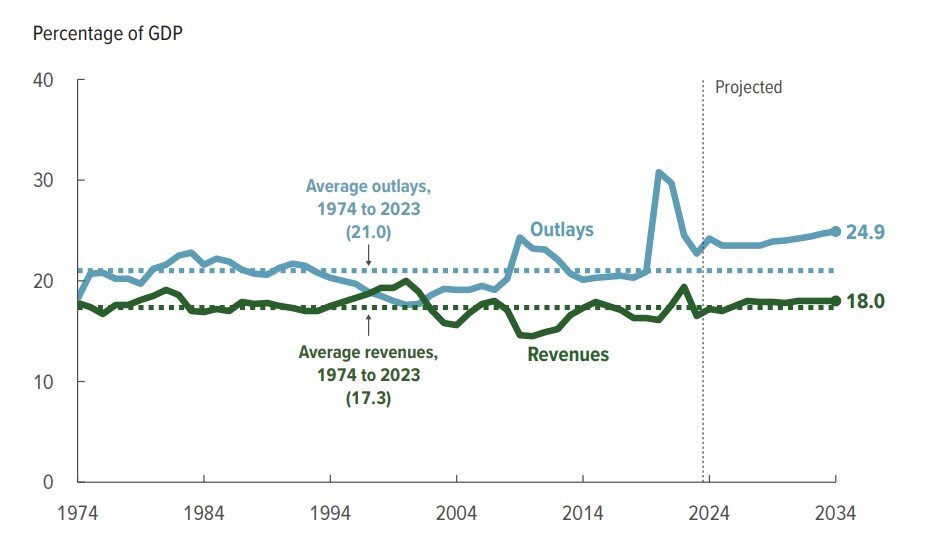Vice President and Democratic presidential nominee Kamala Harris proposes to expand Medicare by having it subsidize in-home long-term care for enrollees—paying for someone to help them with activities of daily living, that sort of thing.
One report estimates the proposal could cost the federal treasury $40 billion per year—more than double the amount of the Children’s Health Insurance Program. Harris would have to pay for it by squeezing inefficiencies from other parts of Medicare, principally Medicare subsidies for prescription drugs.
It is difficult to overstate the irresponsibility, corruption, and insanity of this proposal.
The Fiscal Backdrop
First, consider the fiscal environment into which Harris tosses this proposal.
- The Congressional Budget Office estimates the federal deficit will reach $1.9 trillion this year. Congress will collect $4.9 trillion in revenue but spend $6.8 trillion.
- The deficit spending has been going on so long that the cumulative federal debt now equals 99 percent of the entire US economy. The CBO projects the debt will hit 122 percent of GDP by 2034.
One marvels that politicians are proposing any new spending at all.
Particularly since Congress does not have a revenue problem. It has a spending problem.
- From a historical perspective, Congress is collecting more revenue than usual. Federal revenues currently equal 18 percent of GDP, well above the average of 17.3 percent over the past 50 years.
- Government spending, on the other hand, exceeds the historical average by far more. Over the past 50 years, federal spending has averaged 21 percent of GDP. It currently stands at 24.9 percent. And it is rising faster than revenues.
Into this environment Harris is proposing to create another $40 billion entitlement.
But this proposal wouldn’t make a debt crisis more likely, right? It wouldn’t increase the debt at all because she has a plan to pay for it, right?
An Irresponsible Proposal, Even on Its Own Terms
Not quite.
Even if Congress were not running massive deficits, Harris’s proposal is irresponsible on its own terms.
With one hand she proposes to increase Medicare long-term-care spending by $40 billion. With the other hand, she proposes to cut $40 billion of Medicare drug spending—all without denying benefits to anyone.
If Harris can wring that much inefficiency out of Medicare, she should! If she uses the savings to provide additional benefits to seniors, that’s a huge win for total social welfare! Right?
But consider what Harris’s proposal implicitly admits.
She admits that Medicare currently contains at least $40 billion in wasteful spending. In other words, this health care entitlement wastes so much money that cutting the waste could fund an entirely new entitlement.
Pretty inefficient, right? Now ask yourself: if that’s how much waste government health programs create and tolerate, then what does that say about the wisdom of using those savings to create a new government health care entitlement?
The fact that Congress has a track record of doing exactly that explains much of the mess that is the US health sector. The best estimates indicate that one-third of the $1 trillion Medicare spends annually delivers no benefit to enrollees. That’s more than $300 billion per year. Such staggering levels of waste have fueled the rapid expansion of other government health spending.
Democrats have spent decades milking the Medicare waste-cow to fund new health care entitlements (and now, energy boondoggles). Republicans have also used it to fund new entitlements and (sometimes) to return some of that wasteful spending to taxpayers. The Manhattan Institute’s Chris Pope writes:
Following steep cuts in the 1997 Balanced Budget Act, leading House Democrat Henry Waxman protested that “the Clinton administration and congressional Republicans used Medicare strictly as a piggy-bank.” President Clinton agreed to the Medicare cuts because part of the savings would be used to create the Children’s Health Insurance Program. Despite his criticisms, Waxman had been the architect of similar bipartisan deals in the 1980s to expand Medicaid by cutting Medicare.
When Democrats have controlled Congress, they have pursued this course unilaterally: cuts to Medicare payments to hospitals and insurers were used to fund 40 percent of the 2010 Affordable Care Act’s $1.9 trillion spending (mostly expanding Medicaid). And in 2022, they claimed that cuts to Medicare reimbursement for prescription drugs would pay for over half of the spending in the Inflation Reduction Act.
A good question to ask Democrats would be: if you admit government health care programs are wildly inefficient, how does it make sense to expand the ones we have or to create new ones?
Indeed, Democrats are guilty of a particular hypocrisy here. They complain that the United States is an international outlier on health spending while using the inefficiencies of the government programs that make us an outlier to create more such programs that make us even more of an outlier.
In all likelihood, Harris’s new health care entitlement will exhibit the same staggering rates of wasteful spending as the existing health care entitlement whose waste she hopes will provide the funding. Maybe future Democrats will use the waste from Harris’s new program to fund still more health care entitlements. Lather, rise, repeat.
Cutting Medicare Waste? Don’t Hold Your Breath.
That’s not to say Harris would actually be able to tap that wasteful spending. Even if Congress were to enact her proposal, her plan to free up that wasteful spending is unlikely to work for the same reason that wasteful spending came to exist in the first place. More likely, her proposal would simply add to the federal debt.
Congress has a hard time cutting even wasteful government spending. Why? Every dollar of wasteful spending is a dollar of revenue to somebody—and that person always has a lobbyist. In the case of Harris’s proposal that somebody is the pharmaceutical industry, whose lobbying budget is nearly three times that of the entire defense industry.
Pharmaceutical companies would pull out all the stops to block Harris’s “pay for.” If they fail to stop the legislation, they would come back again and again to try to protect their wasteful revenue. They would lobby Congress to rescind the legislation—as Congress did with the “sustainable growth rate” and the “Cadillac tax.” They would lobby the executive branch to neuter the legislation, as Obama did to ObamaCare’s Medicare Advantage cuts. They would challenge the legislation in federal courts. Big Pharma is right now challenging in court, and lobbying Congress to rescind, the Inflation-Reduction-Act-Medicare-drug-price-negotiation provisions on which Harris hopes to build.
Were Congress to enact Harris’s proposal, therefore, the new spending would remain. (Indeed, the proposal itself would finance a new health care lobby that would fight to preserve it.) But the reductions in wasteful Medicare spending likely would not materialize. If past is prologue, Congress would preserve those wasteful revenues because no one will provide enough push-back against Big Pharma’s lobbying efforts. That’s what happens when politicians and voters spend other people’s money.
The new spending would remain. The cuts would disappear. The federal debt would rise. In all likelihood, Harris’s proposal would bring the United States closer to The Big One: a debt crisis that would force actual, permanent, painful cuts in government spending on necessary care.
Low-Quality Long-Term Care
As if all that wasn’t enough, Harris is building her new entitlement on Medicare—a model that discourages high-quality care and promotes low-quality care. For its entire history, Medicare has had a negative impact on health care quality. As I wrote in 2022:
The non-partisan Medicare Payment Advisory Commission has warned since at least 2003 that Medicare’s approach to health care quality “is largely neutral or negative”….
Since 1965, Medicare has paid providers more for low-quality care than for high-quality care. For example, in 1995, Utah’s Intermountain Health Care reduced mortality by improving how it treated pneumonia. Medicare rewarded those quality improvements by paying Intermountain less.
In 1999, Duke University developed a better way to treat congestive heart failure. Medication adherence increased. Hospitalizations fell. Resource use fell by half. Again, Medicare (and private insurers with similar payment rules) responded by reducing payments. Duke eventually had to shutter the program for lack of funds.
In 2002, Whatcom County, Washington improved glucose management for diabetics and stabilized congestive heart failure patients, saving $3,000 per patient. The county ended up shuttering the program for the same reason Duke did….
In 2009, Medicare reduced payments to Texas’ Baylor Medical Center after the system cut heart-failure readmissions in half with no increase in mortality.
Hospitals can nearly double net revenues if a Medicare patient develops post-operative complications.
Medicare pays hospitals nearly $3,000 more per patient when low-quality care leads to more post-acute care and readmissions.
Medicare paid a large urban hospital system more when it allowed urinary-tract or bloodstream infections than when it prevented them.
Only in recent years has Congress even attempted to correct Medicare’s perverse incentives for low-quality care. Those efforts have failed. My colleague Jacqueline Pohida and I write:
Even Medicare’s quality-improvement programs pay low-quality providers more than high-quality providers, and award quality bonuses to low-quality hospitals and mediocre health plans.
(NB: that’s how Obama gutted ObamaCare’s Medicare Advantage cuts.)
Traditional Medicare is in its sixth decade of penalizing high-quality care and thwarting the competitive forces that would otherwise improve quality. Congress has spent most of Medicare’s history ignoring the program’s negative impact on quality and the resulting harms. Even after a decade of trying to reduce those harms, Medicare’s “development of new payment and care delivery models has had relatively little impact on the average beneficiary and has lagged well behind what is possible and desirable.” The fact that, to this day, congressional debate over Medicare focuses on enrolling more patients in such a program and expanding the range of services it subsidizes, rather than improving the quality of care enrollees receive, is itself an indication that Medicare’s current structure leads Congress to prioritize the needs of industry over the needs of patients
Medicare’s negative impact on quality is systemic. The perverse incentives that encourage low-quality care would infect the provision of the at-home long-term-care services Harris wishes to subsidize. Her proposal is therefore yet another example of prioritizing the needs of the health care industry—in this case, long-term care providers—over the needs of patients.
If Harris truly wanted to provide quality long-term care to Medicare enrollees, she would propose increasing Social Security subsidies for Medicare enrollees who require long-term care.
That too would be fiscally irresponsible (though perhaps slightly less so). But at least the care would be better: Social Security is a far better health care program than Medicare.
Conclusion
Right now, health reporters, health economists, and other Democrats are furiously pounding away at their computer keyboards to proclaim the good news that Harris has issued a compassionate, wise, and responsible at-home-long-term-care proposal.
On the contrary, that proposal is uncompassionate, fiscally reckless, and a corrupt attempt to buy the votes of Medicare enrollees and their middle-aged children in an election year.



